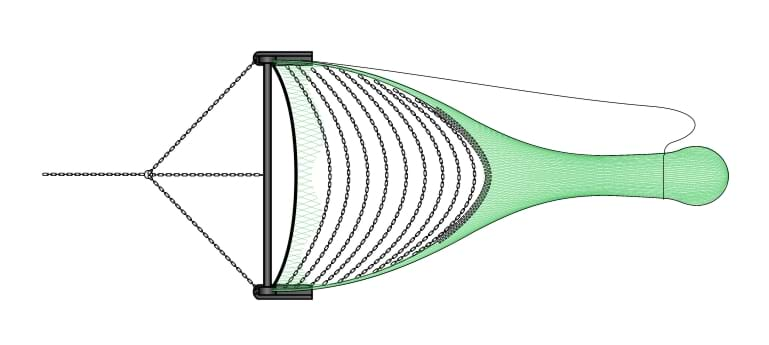Beam Trawl - Open gear
Alternative names
-
- Clean gear
- Open gear
Summary
This is a beam trawl that is rigged to target flat fish on soft sand and muddy sea beds. The open beam gear has series of tickler chains towed ahead of the mouth of the net designed to stimulate the fish out of the mud and over the footrope of the trawl.

Environmental impact
Beam trawling catches a large range of bottom living species and is not a well targeted fishery with often poor selectivity and the potential to catch a wide variety of non target bycatch. This can include crabs, starfish, other shellfish and many other seabed dwelling organisms.
A substantial amount of research in recent years has focused on increasing species selectivity in beam trawls to reduce un wanted bycatch. Recently there has been a big push to improve the selectivity and reduce bycatch in the beam trawl fishery. Project 50% introduced benthic panels, coverless trawls, large mesh top panels and larger mesh nets and cod-ends into the UK beam trawl fishery. This reduced the discard rate by about 50% and many skippers continue to use this modified gear.
There is much criticism of beam trawling due to the belief that it is doing a lot of damage to the seabed. Measures are being put in place and tested to improve on this image. modifications such as fitting the beam with large rubber wheels, fitting rolling rubber bobbins to the footrope, both to help the gear over the seabed with minimum seabed damage. The main driver to introducing the pulse trawl was to improve the environmental credentials of a beam trawl.
Other information
Evolution
The beam trawl is one of the earliest forms of towed fishing gear, being used in the Southern North Sea by the sailing smacks from Grimsby and Lowestoft in the latter part of the 19th century. The net is held open by a rigid framework to maintain the opening of the trawl and despite changes in towing speed. This made it ideal for towing behind early sailing boats with their unpredictable course and speed. As the vessels evolved with modern engines and mechanised gear handling the size of the gear and towing speeds increased in an effort cover a larger area of seabed to increase catches. In the early days of beam trawling only one net was towed from the stern of the boat. Nowadays most commercial beam trawlers use two beam trawls towed from long derricks projecting over each side of the vessel.
Gear
The beam trawl consists of a heavy tubular steel beam supported by steel beam heads at each end. These beam heads have wide shoes at the bottom which slide over the seabed. The beam and beam heads form a rigid framework that keeps the mouth of the trawl open and supports the net. On the early beam trawls and modern day small scale trawls the timber was used for the beam. Nowadays many of the beam trawlers are using aero foil shaped beams, which creates lift as it is towed through the water similar to an aeroplane wing. Access the Beam Trawl - Sumwing record for further information.
The beam is usually towed using a chain bridle arrangement from both shoes and the centre of the beam to the end of the trawl warp leading to the vessel.
A cone shaped net is towed from this framework with the head rope attached to the beam, or Sumwing, and each end of the footrope connected to the bases of the shoes. As the gear is towed over the seabed the footrope forms a ‘U’ shape curve behind the beam and shoes. In the open gear there will be several (as many as ten) 'tickler' chains ahead of the footrope, each one being longer than the one before it to effectively fill the mouth of the trawl with tickler chains to tickle the fish out of the mud and encourage them to rise up far enough to fall back into the trawl. Once in the net the fish will slowly fall back until they are in the cod-end, with the net and cod-end behind this. The headline height of the trawl is limited to the height of the beam off the seabed. Some skippers attach the headline very low down on the beam shoes in and attempt to reduce unwanted bycatch of round fish.
These trawls will be towed for a duration of between twenty minutes to two hours, depending on how much fish is expected on the ground and the type of seabed that the gear is being fished on.
Documents
-
Channel Beam Trawl Roller Ball Foot Rope FEF 0738
-
Comparative Fishing for Flatfish using a Beam Trawl fitted with Electric Ticklers
-
Knowledge Networks towards an economic viable, healthy and sustainable seafood sector
-
New approaches to the reduction of non-target mortality in beam trawling
-
Project 50%
Gear classification
Main target species (UK)
-
- Cuttlefish
- Dover Sole
- Flats
- Lemon Sole
- Monkfish
- Plaice
- Skates
Possible bycatch
-
- Benthos
- Dab
- Flounder
- Immature round fish
- Juveniles of the target species